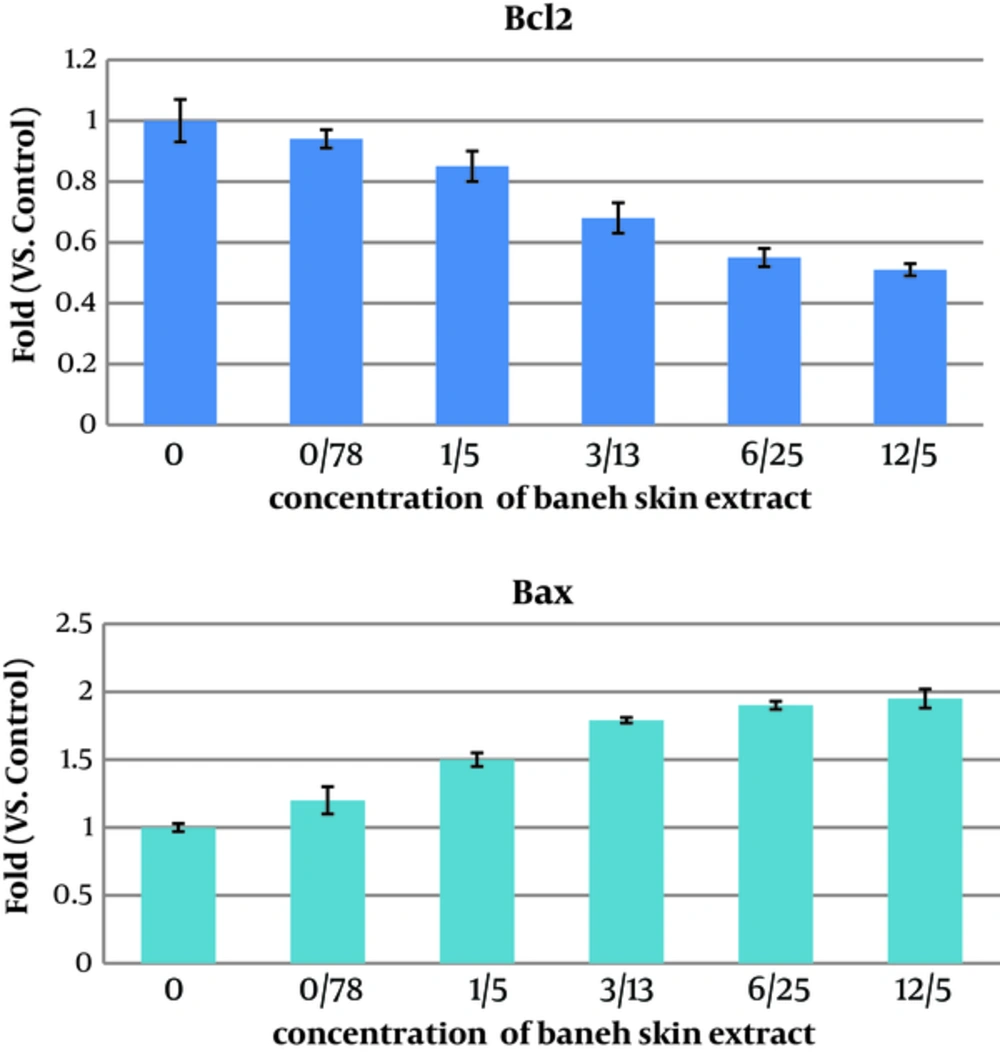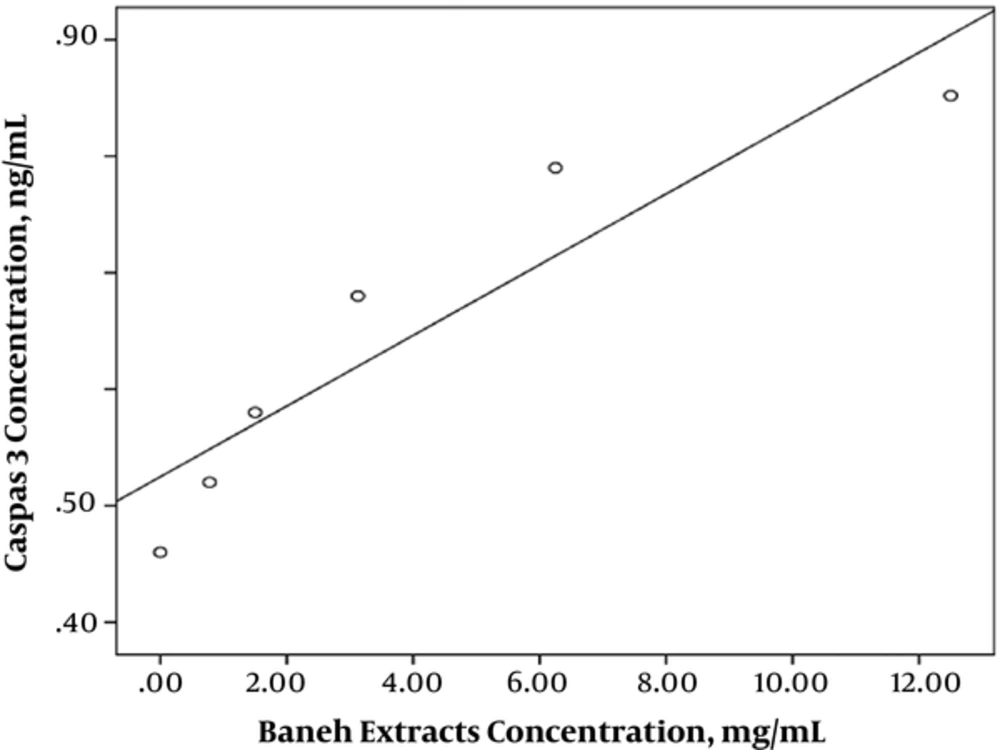1. Background
Prostate cancer is known as one of the most common causes of deaths in men worldwide (1). The incidence rate of prostate cancer in Tehran is more than other provinces in Iran (2). Prostate cancer progresses slowly and metastasis to the bone and lymph nodes. If detected early, prostate cancer can be effectively cured; however, patients mostly refer to the doctors when the disease has already gone to androgen - independent prostate growth; so, androgen - ablative therapies seem to be ineffective in those stages. Some studies are performed to search the novel treatment modalities as well as new targets and anti - cancer agents following the discovery of the clinical impact of advanced prostate cancer (3). Traditional medicine is known as an effective treatment for many diseases; some phytochemicals have been proven to grow the survival of patients and decrease the risk of cancer (4,5). Most of these medicines have significant anti - cancer as well as apoptosis effects through cellular mechanisms and targeting various molecular towards cancer (6). Apoptosis is a very important physiological procedure essential for normal growth and preservation of tissue homeostasis (7). Induction of apoptosis in tumor cells by chemotherapeutic agents is controlled by proportion of Bcl2/Bax proteins in the mitochondria (8). Natural products can affect as apoptosis inducer; so, they can reduce cancer incidence by deleting precancerous cells. Induction of cell death in tumor cells is the final target of cancer chemotherapy (9). Iran is the largest manufacturer of wild pistachio in the world. Wild Pistachio is named Beneh in Iran. Beneh trees, Pistacia atlantica subsp, mutica, from Anacardiaceae family have been growing throughout the central, eastern, and western, parts of Iran (10). Beneh fruit has been used for a diversity of medicinal and nutritional target (11).
2. Objectives
According to the results of our pervious study, Ethanol Baneh skin extract has cytotoxic effect on pc3 cells and also induces apoptosis in prostate cancer cells (12). In this study, we decided to examine the effect of Baneh skin extract on gene expression of bax and bcl - 2 and also caspase3 concentration.
3. Methods
3.1. Materials
We purchased RPMI 1640, Penicillin - Streptomycin, Fetal Bovine Serum (FBS), and Trypsin - EDTA solution from Sigma Aldrich (St. Louis, MO, USA). PC3 prostate cancer cell lines were taken from national cell bank of Iran (Pasteur institute, Iran). Total RNA extraction kit was obtained from GeneALL (Biotech, Korea) and RevertAid First Strand cDNA Synthesis Kit were purchased from Thermo scientific (Thermo Scientific, Schwerte, Germany), respectively. SYBR Green Master Mix was purchased from Takara (Japan). Caspase3 assay kit was obtained from Cusabio Biotech (Wuhan, China).
3.2. Cell Culture
Human prostate cancer cell lines were grown in RPMI 1640 supplemented with 100 mg/mL streptomycin, 100 U/mL penicillin, and 10% fetal bovine serum and in a humidified incubator containing 5% CO2.
3.3. Preparation of Baneh Extract
Fresh unripe fruit from P. atlantica kurdica was gathered from Ilam province, Iran. The fruit skins were dried and, then, powdered, using a mechanical grinder. A total of 10 g of powder was mixed whit 50 mL H2O and 50 mL pure Ethanol for 48 hours and, then, filtrated. The filtrate was evaporated under the reduced pressure in vacuum evaporator and stored at 4 °C. The Baneh extract was died and dissolved in PBS (1 g in 2 mL) and the filter was sterilized. To prepare the working concentrations, the stock solution of the extract was freshly diluted with RPMI 1640 complete culture medium.
3.4. RNA Extraction and Real Time PCR
Pc - 3 cells (5 × 105cells/well) were seeded in 6 - well plate. After 24 hours, the cells were treated with ethanol baneh skin extract (0.78, 1.5, 3.13, 6.25, 12.5 mg/mL) for 48 hours. Then, RNA extraction was performed by kit GeneALL (Biotech, Korea). The concentration and purity was determined, using Nanodrop. For checking the integrity of RNA, extracted RNA was applied on 1% agarose gel to observe 18 s and 28 s bands. Then, using the Revert Aid First Strand cDNA Synthesis kit, 1 µg of total RNA was reverse transcribed to cDNA and Revert Aid Reverse Transcriptase (RT), a recombinant M - MuLV RT. Real time quantitative PCR (Applied Biosystems, USA) was cycled 40 times between 95°C/15 s and 60 °C/1 min, using SYBR Green PCR Master Mix. Expression of Bcl2 and Bax genes was normalized to the internal control (GAPDH), a housekeeping gene. For analysis of real time PCR, Pfaffl method was used. The relative expression ratio (R) of a target gene was calculated based on E and the CP (CT) deviation of an unknown sample versus a control, and expressed and compared to a reference gene.
| Name | Sequences (5' -> 3') |
|---|---|
| bcl - F | CATGTGTGTGGAGAGCGTCAA |
| bcl - R | GCCGGTTCAGGTACTCAGTCA |
| bax - F | GCTGGACATTGGACTTCCTC |
| BAX - R | TCAGCCCATCTTCTTCCAGA |
| GAPDH - F | TGCACCACCAACTGCTTAG |
| GAPDH - R | GATGCAGGGATGATGTTC |
Real Time PCR Primers Sequences
3.5. The Measurement of Caspase - 3
Measuring the caspase3 was used by ELISA method according to protocol. (Cusabio Biotech, Wuhan, China).
3.6. Statistical Analysis
Results were expressed as means ± SD and P < 0.05 was considered statistically significant. Linear regression was used for relationship between increasing baneh extract on caspase3 in pc3 cells. Student’s t - test was used to analyze the effect of different concentrations of Ethanol baneh extract on gene expression. Statistical analyses were performed, using SPSS version 18.
4. Results
4.1. Ethanol Baneh Skin Extract Increased the Expression of Bax Genes and Decreased the Expression of Bcl2 Gene
The mRNA levels of Bax and Bcl2 were analyzed for determining the apoptotic effects of Ethanol baneh skin extract treatment (0.78, 1.5, 3.13, 6.25, 12.5 mg/mL) on pc3 cells after 48 hours. As shown inFigure 1, baneh extract treatment (48 hours) increased bax gene expression and significant reduction was seen in the expression of Bcl2 as compared with the control. To analyze the effect of different concentrations of Ethanol baneh skin extract on gene expression, the paired t - test was used. A significant difference was seen among gene expression of bax and bcl2 to different concentrations of baneh skin extract (0.78, 1.5, 3.13, 6.25 mg/mL), but there was not any significant difference among gene expression bax and bcl2 to bane skin extract in 6.25, 12.5 mg/mL concentrations.
4.2. Ethanol Baneh Skin Extract Increased the Concentration of Caspase3
We exposed pc3 cells to different concentrations of the baneh extract (0.78, 1.5, 3.13, 6.25, 12.5 mg/mL) for 24 hours. According to Linear regression, a significant relationship (P - value < 0.05) was seen, as each unit (mg/mL) increased in baneh skin extract concentration, caspase3 concentration 0.03 ng/mL was increased (Table 2andFigure 2).
| Variable | Regression Coefficient | P Value |
|---|---|---|
| Baneh concentration | 0.03 | 0.01 |
The Effect of Ethanol Baneh Skin Extract on Caspase3 Concentration. As Each Unit (mg/mL) Increased in Baneh Skin Extract Concentration, Caspase3 Concentration 0.7 ng/mL Was Increased.
5. Discussion
Many treatments such as radiotherapy and chemotherapy induced apoptosis in cells (13,14). Side effects of many common cancer treatments made the researchers work on the field of herbal medicine (8). According to epidemiological research, strong evidence shows that environmental factors are affected in the occurrence of some types of human cancer (15). Natural anti - oxidants decrease the risk of chronic diseases, cancer, diabetes, and cardiovascular disease; so, they are important for human health (16). Deletion of tumors by the infusion of apoptosis is the most common mechanism of cancer therapeutics (17). One of the first regulators of apoptosis is bcl - 2 that is known as anti - apoptotic member of bcl - 2 family (18). It is encoded as a human proto - oncogene (19) and represses apoptosis by blocking the escape of cytochrome c from the mitochondria to prevent the activation of caspases (18). Damage or stress signals induce Bax monomers oligomerization, and conductance to the release the pro apoptotic proteins and activation of some caspases (20). Researchers have recently considered the role of family of caspase proteases (21). Apoptosis is the programed cell death, in which caspase3 plays upstream “initiator” roles (22,23). Polyphenolic compounds of plants and flavonoids are well known as dietary anti - oxidants Pistacia species contain source of natural anti - oxidants, flavonoids, and phenolics such as quercetin and a - tocopherol (24). Phenols have an effect on cell cycle arrest and they can activate apoptotic signal transduction pathways in cancerous cells (25). There are a number of medical species in Anacardiaceae family, which contain special compounds with anti-bacterial, fungicidal, and cytotoxic effects. In addition, some studies have approved the cytotoxic activity of the extract of Lithraea molleoides (Anacardiaceae) on HepG2 cells. Some examples are the effects of Semecarpus anacardium nut oil on growth inhibition in leukemia cell lines and the cytotoxic effects of its nuts on breast cancer cell line (26). Gum mastic (GM) of P. lentiscus var chia has anti - proliferative effect of on prostate and colon cancer cell lines (3). The flavonid amount of Baneh (Pistacia atlantica sub kurdica) extract was more than the extract of the P. atlantica Desf leaves and P. terebinthus fruits (27). The amount of DPPH IC50 in the Baneh extract was more than in the DPPH IC50 of P. atlantica leaves and the P. lentiscus fruits (28). Analyzing the phenolic combination in different part of baneh was found in hull and shell extracts of all genotypes, Baneh from Ilam province has the highest phenolic content and antioxidant activity, for this reason, in this study the skin of bane fruit from Ilam was used (29). Natural compounds have toxic effects and interfere via apoptotic pathways and compounds with pro apoptotic effects intercept cancer incidence by enhancing the deletion of original precancerous cells. As it is known for polar compounds to have anti - cancer effects, generally alcoholic extracts were used for anti - cancer screening (30). Baneh extract indicated cytotoxic effect and apoptosis effect in human breast cancer T47D cells (29) and pericarp polyphenol - rich extract of Baneh induction of apoptosis and cell cycle arrest in human colon carcinoma HT29 cells (27). In previous study, we confirmed that Ethanol baneh skin extract has anti - cancer and inhibitory effect on prostate cancer cells is in a time- and dose - dependent manner (11). The molecular analysis of apoptosis proved the activation of caspase3 more efficiently in Baneh than in Doxorubicin treated cancer cells (29). With respect to these results, we decided to examine the effect of baneh skin extract on bcl2 and bax expression and caspase3 concentration for the first time.
In this study, the mRNA expression levels of Bax and Bcl2 genes, which are involved in apoptosis, were investigated. All gene expressions were normalized to GAPDH (reference gene). The results showed that the mRNA levels of bax were increased and the mRNA levels of bcl2 were decreased in pc - 3 cells after treatment with Ethanol baneh skin extract for 48 hours; so, the ratio of Bcl - 2/Bax was increased. Caspases are important agents in apoptosis. Caspase3 is an executive caspase in both inner and outer pathway. Based on the results of this study, caspase3 concentration in pc3 cells was increased by baneh extract. In summary, Ethanol baneh skin extract could induce apoptosis in pc - 3 cells through the modulation of expression of Bax and bcl - 2 genes. Baneh extract increased Bax gene expression and decreased the expression of Bcl2, and also increased caspase3 concentration. However, further studies are necessary to understand the exact mechanisms of the activities of baneh skin extract.

